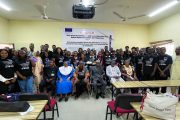A university is as good as what its academics publish. This is more so if it is a fairly new but an ambitious university such as Veritas University, Abuja which aspires to be an intellectual hub. To be an intellectual hub means a university must transcend the radius of the pedestrian and provide more imaginative and bolder interpretation of unsettled questions.
It is in this context that Metaphors of Reconciliation: Church Versus Culture must be something to celebrate, albeit critically. Those who accept the standpoint of the book will dance about it all over the world. Those who might have reservations about it have the option of opening a counter-analysis. Either way, there are no losers but only winners, including all other faiths, sects and players in the world of religion. The point cannot be overstated that since Catholicism was classified as one of the eight civilisations whose clashes would define world politics in the post Cold War, the identity element in the faith has become an issue. As such, a book of this nature becomes a book for everybody, a dialogue between civilisations in the mega civilisation and faith called Catholicism.
The book is not what its kicker tells you, the kicker which made the pursuit of the author an emergency that hot afternoon when this reviewer first sighted it in an office and thought it was about metaphor as the connector between language or communication and conflict. Instead, it is the rider or sub-title that tells you what the book is about. In other words, reconciliation here does not refer to what comes after two or more conflict parties have drawn daggers. Rather, it is reconciliation in terms of correctional practices to restore the covenant between God and humans which man’s rebellion broke up, thereby rupturing God’s plan for the human race. But the rites or terms for this reconciliation that came to Africa, for example came in the European imagination and its ethos. That has created a question mark on the status of the African imaginary in received Christian faith. Is it one of conflict or what?

Rev Fr Barnabas Sama’ila Shabayang, the author

Cardinal Francis Arinze at a function at Veritas University
Reverend Father Barnabas Sama’ila Shabayang, the author who teaches Religion and Intercultural Studies at Veritas University, Abuja is stepping out to say that there is no conflict between what Professor Cletus Tanimu Gotan who wrote the Foreword calls the creedal metaphors and the cultural metaphors. That is to say that creedal metaphors do not constitute an oppositional category to the spoken words, graphic symbols, riddles, proverbs, figures of speech, language, art, myths and metaphysical rites that collectively define the African-self. They are, instead, also conceptual entities or language of Catholicism/Christianity. What one might consider the peg of this standpoint is where the author writes: “These are metaphors of reconciliation metaphors of reconciliation when well integrated into the faith-based intellectual formation of our youths and adults can instil a sense of guilt, shame and invoke repentance that must lead to reconciliation with God and the Church or the Islamic faith within a given community in Nigeria/Africa”, (p. 73).
The author moves on to outline the import of the argument where he draws attention to the peace or war making power of the spoken word in African cosmology similar to the criminal justice system. This is what happens when cultural variables such as food, wine, cola nuts are appropriately invoked to by elders, priest-kings and, in the end, ancestors to secure lasting peace even for crimes of incest, rape or murder which are crimes against God before they are crimes against fellow man.
Locating this position in a grand thesis thereto, Shabayang quotes John Cardinal Onaiyekan’s argument that “in the African culture, the religious dimension is not only the most important but that which ties all other dimensions together”, (p. 86). That is to say that inculturation goes farther than liturgical or theological inculturation, Church governance, spirituality and the religious life. Interestingly, this is also the position of Europeans who support “… the contextual nature of Christian theology in African worldview”, (P. 87).

Veritas University, Abuja VC, Prof Mike Kwanashie; the Representative of the Emir of Kano to a Veritas Universuty function, Prof Isah Hashim and John Cardinal Onaiyekan
The argument gets more and more seductive when Shabayang who is over 25 years in priesthood elaborates the point that what constitutes metaphors in African cosmology extends farther but includes understanding of metaphors in European and American literary arts. He, however, identifies the major difference between the African and the Euro-American in how the choice and application of cultural metaphors in African cosmic space are in the richness of the speech of the elders, elders who speak in unison with the ancestors, conveying their great wisdom in proverbs, riddles and abstract concepts and/or employing the medium of food, wine and cola nuts, among others.
It must be all these pointed strokes that made the Very Reverend Fr Paul Enow of the Catholic Archdiocese of Benin City to say that the author has placed a “liberating tool within the grasp of the ordinary person”, (P. xvii). But, who knows, they might have also been referring to some of the beautiful phrases one comes across in sweeping through the book: Divine encounter of God and human beings”, (p. 69); Synodal assemblies”, (p. 70); “Divine alert”, (p. 72) and “a medicine of mediation”, (p. 120).
Without pretending to know anything in Theology, one could still say that the gist of this intervention is a case for inter-discursivity in religion, not just Catholicism. And it is a very important intervention because, otherwise, those who want to be Christians but also bear their native names, for example, could be left wondering for too long. In other words, monologism can be problematic, even in religion as it is in politics, business and culture. Catholicism has, thankfully, been sensitive to this as to have, ever since, maintained an elaborate inculturation process. This is besides its strong history of provoking and promoting discourses.
To that extent, it would be a disservice to academia, Africa and the Church if the author would not consider re-issuing the book, using that process to pay a lot of editorial attention to the entire work and to ensure that it is published by a university press. It can still come out as a 133 page, five chapter book which it is now just as it could still retain the methodology which enabled as many cultural groups in Nigeria to speak on the issue: Bajju; Hausa; Igbo; Yoruba; Gbagi; Idoma; Angas; Atyap; Berom; Oegorok; Ikulu and Chamba.




























